Patho hesi exit exam - Study guides, Class notes & Summaries
Looking for the best study guides, study notes and summaries about Patho hesi exit exam? On this page you'll find 26 study documents about Patho hesi exit exam.
Page 3 out of 26 results
Sort by
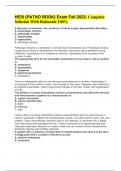
-
HESI (PATHO BOOK) Exam Fall 2022. Complete Solution With Rationale 100%
- Exam (elaborations) • 63 pages • 2024
-
- $15.98
- + learn more
HESI (PATHO BOOK) Exam Fall 2022. Complete Solution With Rationale 100% A decrease in workload, use, pressure, or blood supply appropriately describes: A. physiologic atrophy. B. pathologic atrophy. C. hypertrophy. D. hyperplasia. B. pathologic atrophy. Pathologic atrophy is a decrease in cell size due to decreased use. Physiologic atrophy usually occurs early in development; for example, the thymus gland atrophies during childhood. Hypertrophy is an increase in cell size. Hyperplasia...
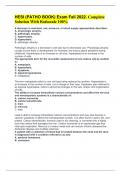
-
HESI (PATHO BOOK) Exam Fall 2022. Complete Solution With Rationale 100%
- Exam (elaborations) • 63 pages • 2024
-
- $18.99
- + learn more
HESI (PATHO BOOK) Exam Fall 2022. Complete Solution With Rationale 100% A decrease in workload, use, pressure, or blood supply appropriately describes: A. physiologic atrophy. B. pathologic atrophy. C. hypertrophy. D. hyperplasia. B. pathologic atrophy. Pathologic atrophy is a decrease in cell size due to decreased use. Physiologic atrophy usually occurs early in development; for example, the thymus gland atrophies during childhood. Hypertrophy is an increase in cell size. Hyperplasia...
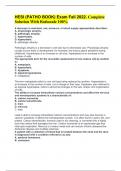
-
HESI (PATHO BOOK) Exam Fall 2022. Complete Solution With Rationale 100%
- Exam (elaborations) • 63 pages • 2024
-
- $14.99
- + learn more
HESI (PATHO BOOK) Exam Fall 2022. Complete Solution With Rationale 100% A decrease in workload, use, pressure, or blood supply appropriately describes: A. physiologic atrophy. B. pathologic atrophy. C. hypertrophy. D. hyperplasia. B. pathologic atrophy. Pathologic atrophy is a decrease in cell size due to decreased use. Physiologic atrophy usually occurs early in development; for example, the thymus gland atrophies during childhood. Hypertrophy is an increase in cell size. Hyperplasia...
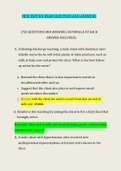
-
HESI EXIT RN EXAM QUESTION AND ANSWERS
- Exam (elaborations) • 449 pages • 2021
-
- $13.99
- 1x sold
- + learn more
HESI EXIT RN EXAM QUESTION AND ANSWERS (750 QUESTIONS AND ANSWERS, RATIONALE OF EACH ANSWER INCLUDED) 1. Following discharge teaching, a male client with duodenal ulcer tells the nurse the he will drink plenty of dairy products, such as milk, to help coat and protect his ulcer. What is the best follow-up action by the nurse? a. Remind the client that it is also important to switch to decaffeinated coffee and tea. b. Suggest that the client also plan to eat frequent small meals to r...
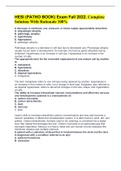
-
HESI (PATHO BOOK) Exam Fall 2022. Complete Solution With Rationale 100%
- Exam (elaborations) • 63 pages • 2023
-
- $13.89
- + learn more
HESI (PATHO BOOK) Exam Fall 2022. Complete Solution With Rationale 100% A decrease in workload, use, pressure, or blood supply appropriately describes: A. physiologic atrophy. B. pathologic atrophy. C. hypertrophy. D. hyperplasia. B. pathologic atrophy. Pathologic atrophy is a decrease in cell size due to decreased use. Physiologic atrophy usually occurs early in development; for example, the thymus gland atrophies during childhood. Hypertrophy is an increase in cell size. Hyperplasia...
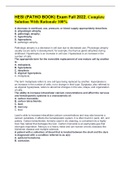
-
HESI (PATHO BOOK) Exam Fall 2022. Complete Solution With Rationale 100%
- Exam (elaborations) • 63 pages • 2023
-
- $15.49
- + learn more
HESI (PATHO BOOK) Exam Fall 2022. Complete Solution With Rationale 100% A decrease in workload, use, pressure, or blood supply appropriately describes: A. physiologic atrophy. B. pathologic atrophy. C. hypertrophy. D. hyperplasia. B. pathologic atrophy. Pathologic atrophy is a decrease in cell size due to decreased use. Physiologic atrophy usually occurs early in development; for example, the thymus gland atrophies during childhood. Hypertrophy is an increase in cell size. Hyperplasia...

Did you know that on average a seller on Stuvia earns $82 per month selling study resources? Hmm, hint, hint. Discover all about earning on Stuvia


